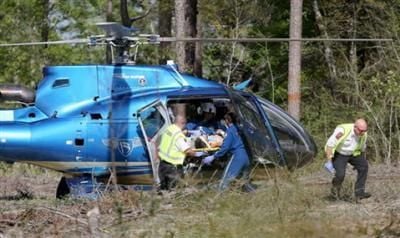Aircraft narrowly lead fatalities list in wildland fire study

Associated Press
First responders load a victim into a LifeFlight medevac helicopter after a helicopter crash in Mississippi's DeSoto National Forest March 30. Helena National Forest employee Brenden Mullen was the sole survivor of the crash. Two others died.
August 06, 2015
By Rob Chaney
Retardant bombers and helitack teams might be safer if they talked more with the wildland firefighters they’re defending on the ground, according to a new study by the federal Centers for Disease Control and Prevention.
Aircraft accidents are the leading cause of death in forest fires by a slight margin, the study found. The category accounted for 26 percent of fatalities between 2000 and 2013.
Tied for second place were vehicle incidents (including rollovers and being hit by a vehicle) at 23 percent, and medical events such as heart attacks at 23 percent. The fourth leading cause was burn-overs or entrapment by the forest fire itself, at 15 percent.
“One thing we would encourage is more communication with people on the ground,” said Mary O’Connell, one of the lead authors of the study. “Tragically in aviation, the aviation component of a firefighting group communicates mainly amongst itself. We encourage expanding the definition of crew to not just the cockpit or tower, so we’re drawing in help from all areas that the pilots might not be aware of otherwise.”
O’Connell said ground firefighters on the scene might provide better advice on how winds shift around a water-dipping pond or obstructions at a landing zone.
“Firefighting always involves a diverse group of agencies, and sometimes that group isn’t totally united,” O’Connell said. “You haven’t trained together, so you’re not a well-oiled machine. That requires more attention paid to activities and operations.”
Dan Snyder of Missoula-based Neptune Aviation has seen a preliminary version of the study. He said it reinforces an effort the wildfire aviation industry has been working on for several years.
“More communication never hurts -- that’s always true,” Snyder said. “The biggest thing in aerial firefighting now is the Safety Management System, or SMS, that’s come along in the last five years.”
SMS is a method of reviewing an entire organization, government or private, for how each activity affects safety.
“It takes in everything from executive management to pilot decisions in the cockpit,” Snyder said. “It puts everything through a risk analysis centered around the idea of safety.”
To get their statistics for the National Institute for Occupational Safety and Health report, O’Connell and co-researcher Corey Butler gleaned several different state and federal data sets of workplace injuries and fatalities.
They also expanded some categories to better classify deaths that show up in one set but not another.
In the case of aviation-related fatalities, they combined aircraft crash incidents with deaths of smokejumpers or helitack firefighters, whose planes may not have had any reportable problems.
The study looked at 298 wildland firefighter fatalities over the 13-year period. They found 41 aviation-related events that killed 78 people. About a quarter of those involved some kind of mechanical failure in the aircraft, while another quarter was attributed to the pilot’s loss of control.
Private contractors employed 42 of the 78 aviation victims, followed by the federal government (15), state agencies (10), ground contractors (7) and the military (4).
California was the site of a quarter of the deaths, with eight occurring in Nevada and seven in Idaho.
The study was limited by several factors. The authors said they weren’t able to reliably gather information on aviation deaths that might have occurred on training missions, maintenance or transit to or from a fire.
They also had difficulty determining the total population of wildland firefighters, because of the variety of local fire departments, prison inmate crews and interrelated state agencies that all provide help at a forest fire.
And perhaps most critically, they found it hard to devise a good measuring stick to see what trends might flow from their statistics.
For example, they found the number of aviation-related fatalities was higher between 2000 and 2006 (28) than 2007 and 2013 (13), but that straddles a period when the federal government briefly grounded most of its large air tankers after a series of fatal crashes in 2004.
Just over half the incidents involved airplanes, with helicopters making up 45 percent. Causes ranged from engine failure to midair collision to failure of rappelling gear in a helitack mission.